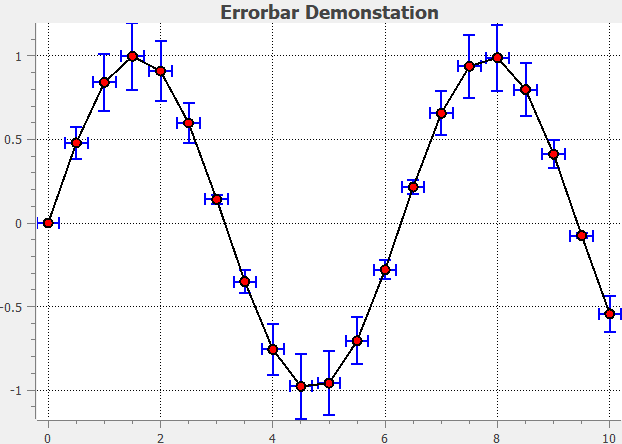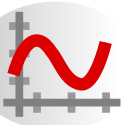import numpy as np
from qtpy.QtCore import QLineF, QRectF, QSize, Qt
from qtpy.QtGui import QBrush, QPen
from qwt import QwtPlot, QwtPlotCurve, QwtPlotGrid, QwtSymbol
from qwt.tests import utils
class ErrorBarPlotCurve(QwtPlotCurve):
def __init__(
self,
x=[],
y=[],
dx=None,
dy=None,
curvePen=None,
curveStyle=None,
curveSymbol=None,
errorPen=None,
errorCap=0,
errorOnTop=False,
):
"""A curve of x versus y data with error bars in dx and dy.
Horizontal error bars are plotted if dx is not None.
Vertical error bars are plotted if dy is not None.
x and y must be sequences with a shape (N,) and dx and dy must be
sequences (if not None) with a shape (), (N,), or (2, N):
- if dx or dy has a shape () or (N,), the error bars are given by
(x-dx, x+dx) or (y-dy, y+dy),
- if dx or dy has a shape (2, N), the error bars are given by
(x-dx[0], x+dx[1]) or (y-dy[0], y+dy[1]).
curvePen is the pen used to plot the curve
curveStyle is the style used to plot the curve
curveSymbol is the symbol used to plot the symbols
errorPen is the pen used to plot the error bars
errorCap is the size of the error bar caps
errorOnTop is a boolean:
- if True, plot the error bars on top of the curve,
- if False, plot the curve on top of the error bars.
"""
QwtPlotCurve.__init__(self)
if curvePen is None:
curvePen = QPen(Qt.NoPen)
if curveStyle is None:
curveStyle = QwtPlotCurve.Lines
if curveSymbol is None:
curveSymbol = QwtSymbol()
if errorPen is None:
errorPen = QPen(Qt.NoPen)
self.setData(x, y, dx, dy)
self.setPen(curvePen)
self.setStyle(curveStyle)
self.setSymbol(curveSymbol)
self.errorPen = errorPen
self.errorCap = errorCap
self.errorOnTop = errorOnTop
def setData(self, *args):
"""Set x versus y data with error bars in dx and dy.
Horizontal error bars are plotted if dx is not None.
Vertical error bars are plotted if dy is not None.
x and y must be sequences with a shape (N,) and dx and dy must be
sequences (if not None) with a shape (), (N,), or (2, N):
- if dx or dy has a shape () or (N,), the error bars are given by
(x-dx, x+dx) or (y-dy, y+dy),
- if dx or dy has a shape (2, N), the error bars are given by
(x-dx[0], x+dx[1]) or (y-dy[0], y+dy[1]).
"""
if len(args) == 1:
QwtPlotCurve.setData(self, *args)
return
dx = None
dy = None
x, y = args[:2]
if len(args) > 2:
dx = args[2]
if len(args) > 3:
dy = args[3]
self.__x = np.asarray(x, float)
if len(self.__x.shape) != 1:
raise RuntimeError("len(asarray(x).shape) != 1")
self.__y = np.asarray(y, float)
if len(self.__y.shape) != 1:
raise RuntimeError("len(asarray(y).shape) != 1")
if len(self.__x) != len(self.__y):
raise RuntimeError("len(asarray(x)) != len(asarray(y))")
if dx is None:
self.__dx = None
else:
self.__dx = np.asarray(dx, float)
if len(self.__dx.shape) not in [0, 1, 2]:
raise RuntimeError("len(asarray(dx).shape) not in [0, 1, 2]")
if dy is None:
self.__dy = dy
else:
self.__dy = np.asarray(dy, float)
if len(self.__dy.shape) not in [0, 1, 2]:
raise RuntimeError("len(asarray(dy).shape) not in [0, 1, 2]")
QwtPlotCurve.setData(self, self.__x, self.__y)
def boundingRect(self):
"""Return the bounding rectangle of the data, error bars included."""
if self.__dx is None:
xmin = min(self.__x)
xmax = max(self.__x)
elif len(self.__dx.shape) in [0, 1]:
xmin = min(self.__x - self.__dx)
xmax = max(self.__x + self.__dx)
else:
xmin = min(self.__x - self.__dx[0])
xmax = max(self.__x + self.__dx[1])
if self.__dy is None:
ymin = min(self.__y)
ymax = max(self.__y)
elif len(self.__dy.shape) in [0, 1]:
ymin = min(self.__y - self.__dy)
ymax = max(self.__y + self.__dy)
else:
ymin = min(self.__y - self.__dy[0])
ymax = max(self.__y + self.__dy[1])
return QRectF(xmin, ymin, xmax - xmin, ymax - ymin)
def drawSeries(self, painter, xMap, yMap, canvasRect, first, last=-1):
"""Draw an interval of the curve, including the error bars
painter is the QPainter used to draw the curve
xMap is the QwtDiMap used to map x-values to pixels
yMap is the QwtDiMap used to map y-values to pixels
first is the index of the first data point to draw
last is the index of the last data point to draw. If last < 0, last
is transformed to index the last data point
"""
if last < 0:
last = self.dataSize() - 1
if self.errorOnTop:
QwtPlotCurve.drawSeries(self, painter, xMap, yMap, canvasRect, first, last)
# draw the error bars
painter.save()
painter.setPen(self.errorPen)
# draw the error bars with caps in the x direction
if self.__dx is not None:
# draw the bars
if len(self.__dx.shape) in [0, 1]:
xmin = self.__x - self.__dx
xmax = self.__x + self.__dx
else:
xmin = self.__x - self.__dx[0]
xmax = self.__x + self.__dx[1]
y = self.__y
n, i = len(y), 0
lines = []
while i < n:
yi = yMap.transform(y[i])
lines.append(
QLineF(xMap.transform(xmin[i]), yi, xMap.transform(xmax[i]), yi)
)
i += 1
painter.drawLines(lines)
if self.errorCap > 0:
# draw the caps
cap = self.errorCap / 2
(
n,
i,
) = (
len(y),
0,
)
lines = []
while i < n:
yi = yMap.transform(y[i])
lines.append(
QLineF(
xMap.transform(xmin[i]),
yi - cap,
xMap.transform(xmin[i]),
yi + cap,
)
)
lines.append(
QLineF(
xMap.transform(xmax[i]),
yi - cap,
xMap.transform(xmax[i]),
yi + cap,
)
)
i += 1
painter.drawLines(lines)
# draw the error bars with caps in the y direction
if self.__dy is not None:
# draw the bars
if len(self.__dy.shape) in [0, 1]:
ymin = self.__y - self.__dy
ymax = self.__y + self.__dy
else:
ymin = self.__y - self.__dy[0]
ymax = self.__y + self.__dy[1]
x = self.__x
(
n,
i,
) = (
len(x),
0,
)
lines = []
while i < n:
xi = xMap.transform(x[i])
lines.append(
QLineF(xi, yMap.transform(ymin[i]), xi, yMap.transform(ymax[i]))
)
i += 1
painter.drawLines(lines)
# draw the caps
if self.errorCap > 0:
cap = self.errorCap / 2
n, i, j = len(x), 0, 0
lines = []
while i < n:
xi = xMap.transform(x[i])
lines.append(
QLineF(
xi - cap,
yMap.transform(ymin[i]),
xi + cap,
yMap.transform(ymin[i]),
)
)
lines.append(
QLineF(
xi - cap,
yMap.transform(ymax[i]),
xi + cap,
yMap.transform(ymax[i]),
)
)
i += 1
painter.drawLines(lines)
painter.restore()
if not self.errorOnTop:
QwtPlotCurve.drawSeries(self, painter, xMap, yMap, canvasRect, first, last)
class ErrorBarPlot(QwtPlot):
def __init__(self, parent=None, title=None):
super(ErrorBarPlot, self).__init__("Errorbar Demonstation")
self.setCanvasBackground(Qt.white)
self.plotLayout().setAlignCanvasToScales(True)
grid = QwtPlotGrid()
grid.attach(self)
grid.setPen(QPen(Qt.black, 0, Qt.DotLine))
# calculate data and errors for a curve with error bars
x = np.arange(0, 10.1, 0.5, float)
y = np.sin(x)
dy = 0.2 * abs(y)
# dy = (0.15 * abs(y), 0.25 * abs(y)) # uncomment for asymmetric error bars
dx = 0.2 # all error bars the same size
errorOnTop = False # uncomment to draw the curve on top of the error bars
# errorOnTop = True # uncomment to draw the error bars on top of the curve
symbol = QwtSymbol(
QwtSymbol.Ellipse, QBrush(Qt.red), QPen(Qt.black, 2), QSize(9, 9)
)
curve = ErrorBarPlotCurve(
x=x,
y=y,
dx=dx,
dy=dy,
curvePen=QPen(Qt.black, 2),
curveSymbol=symbol,
errorPen=QPen(Qt.blue, 2),
errorCap=10,
errorOnTop=errorOnTop,
)
curve.attach(self)
def test_errorbar():
"""Errorbar plot example"""
utils.test_widget(ErrorBarPlot, size=(640, 480))
if __name__ == "__main__":
test_errorbar()

